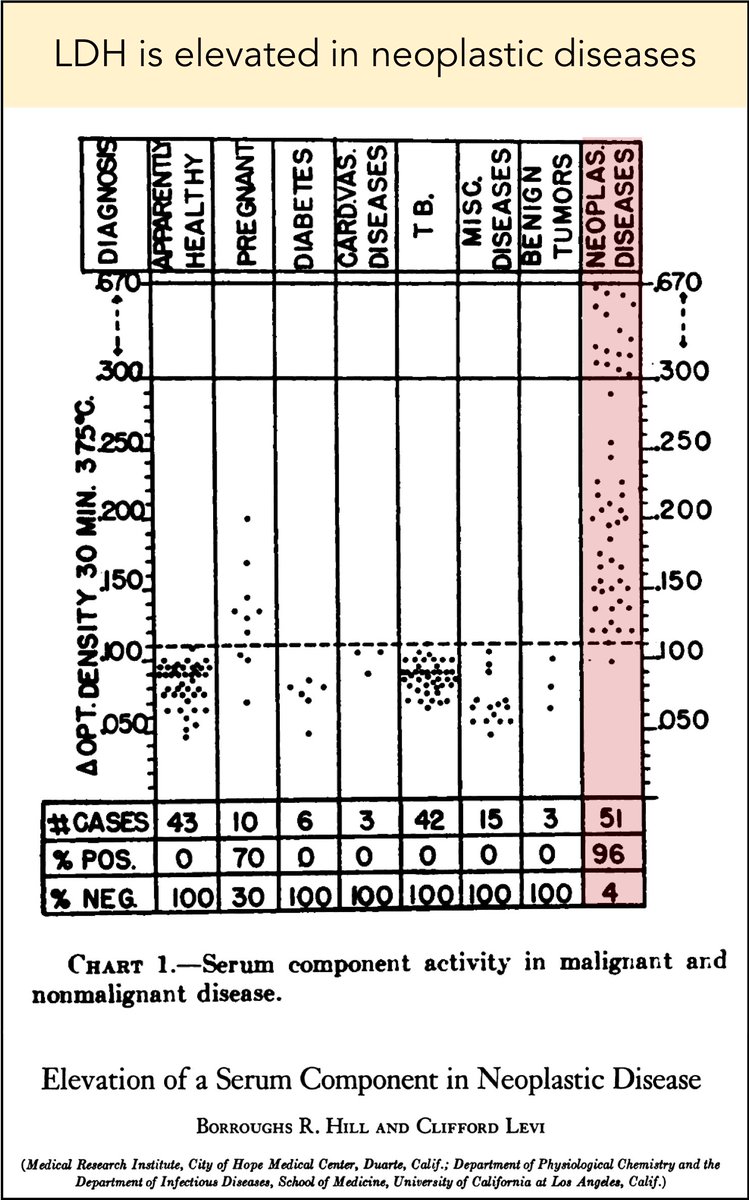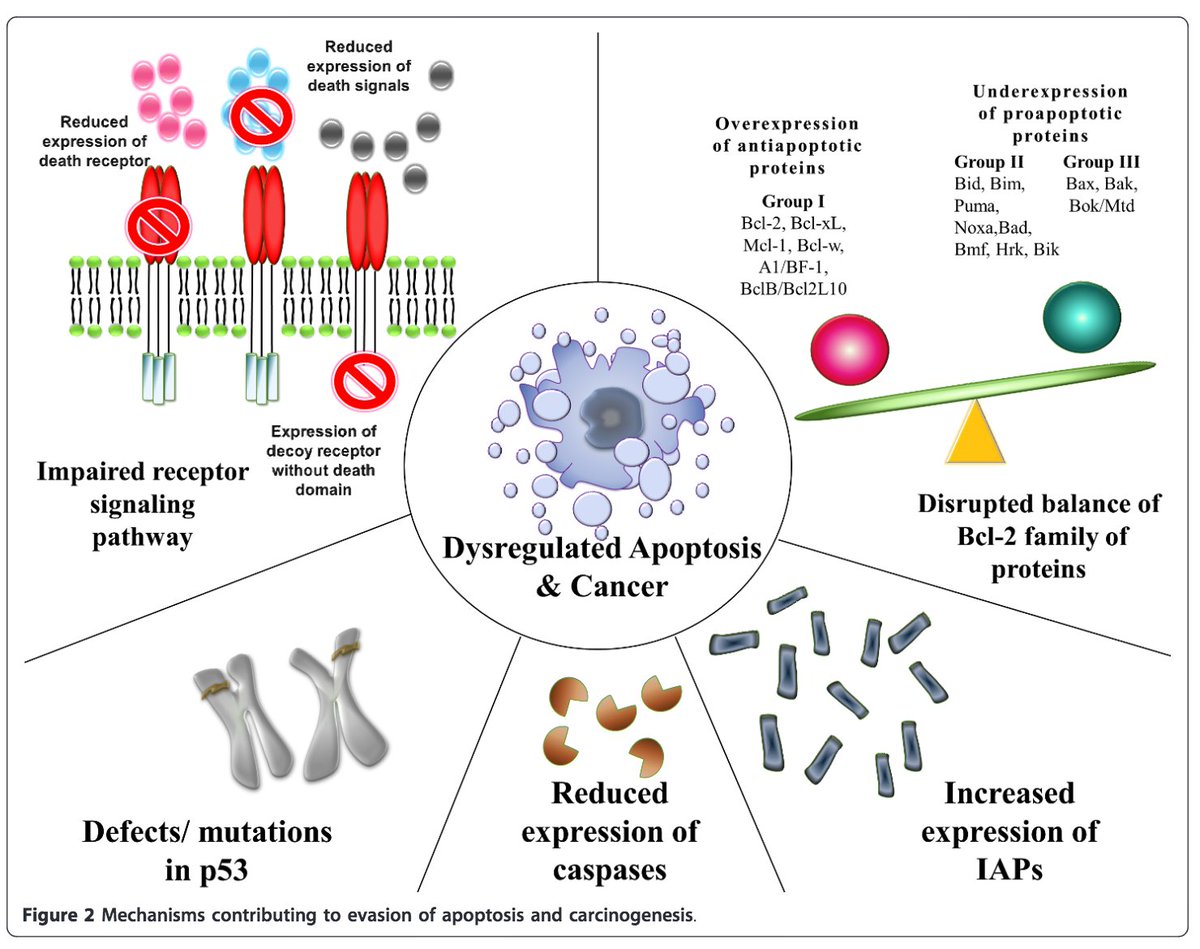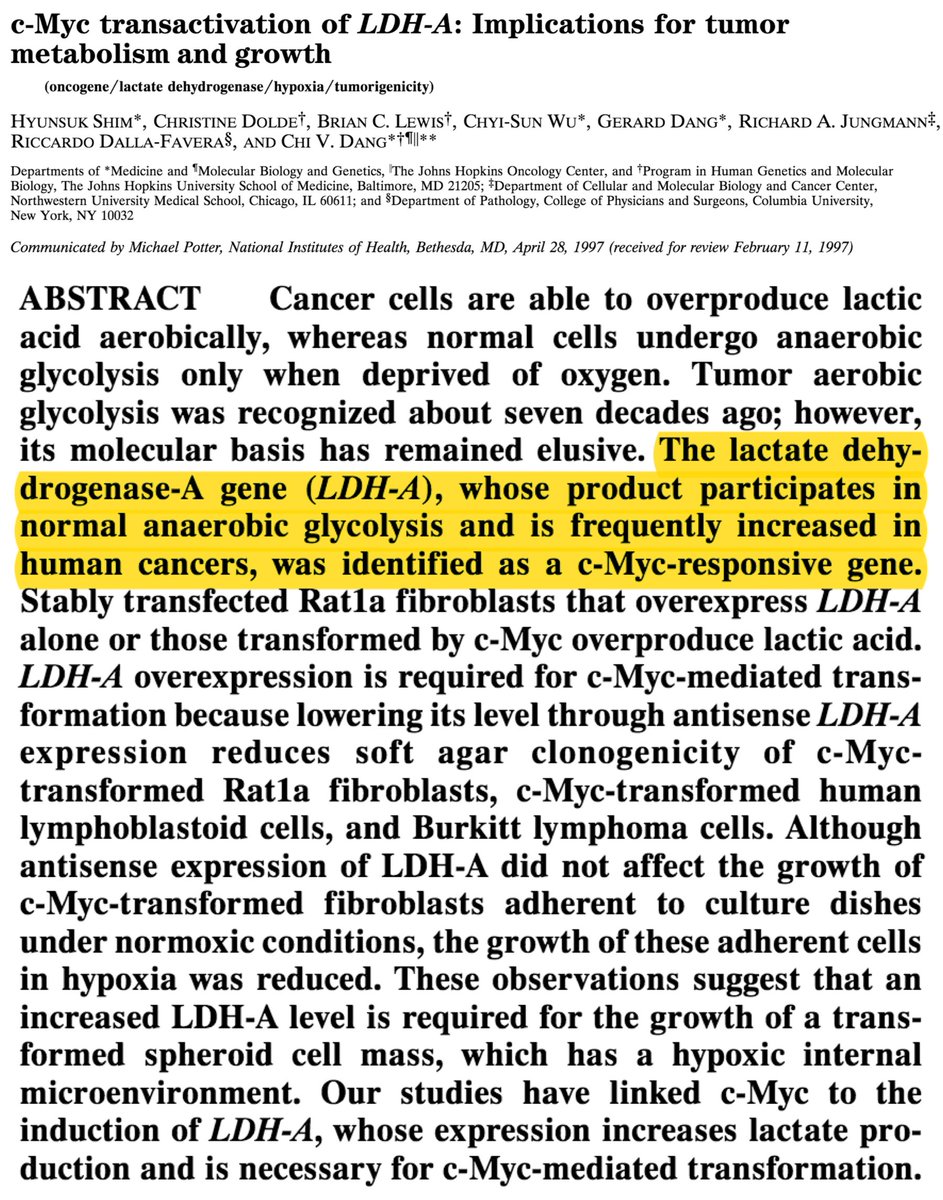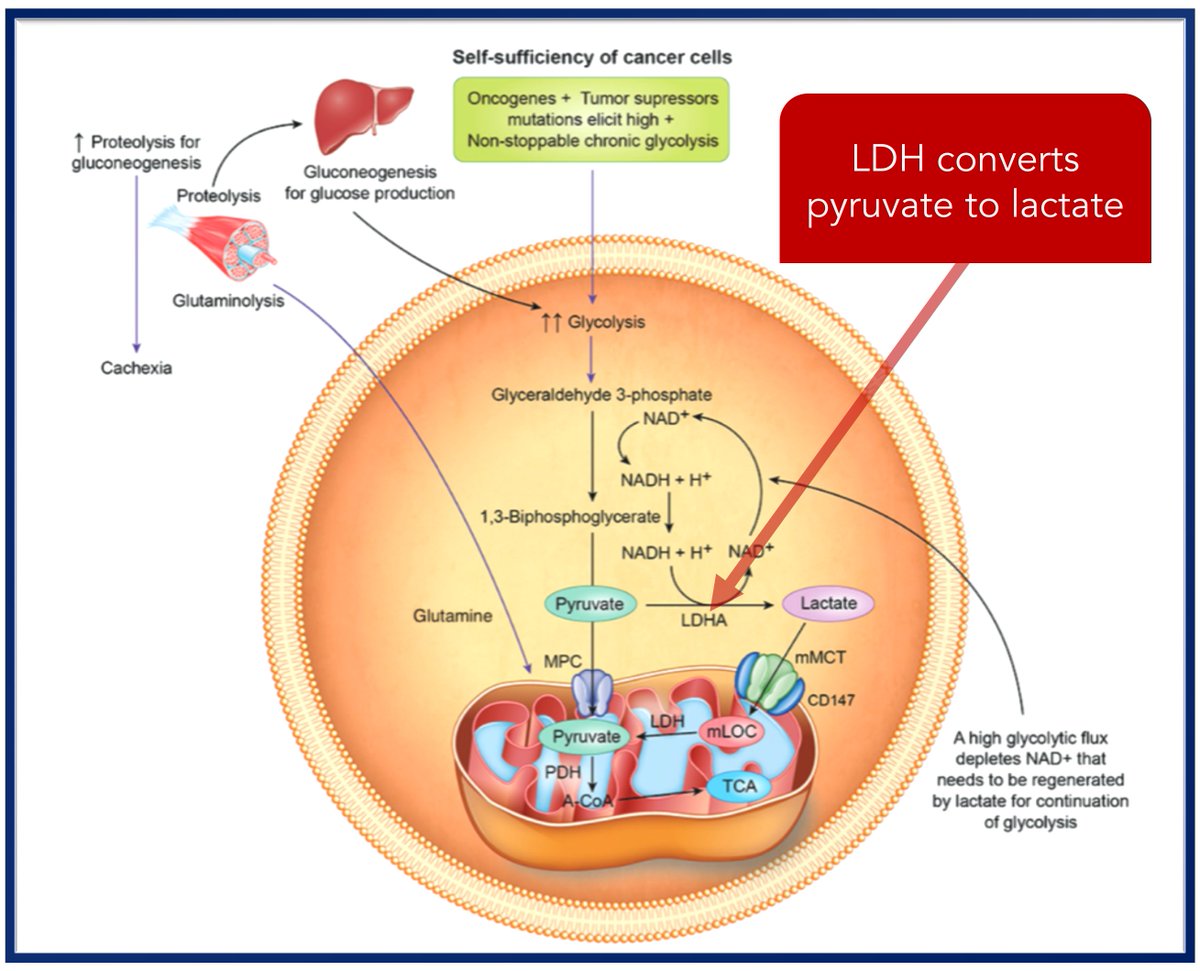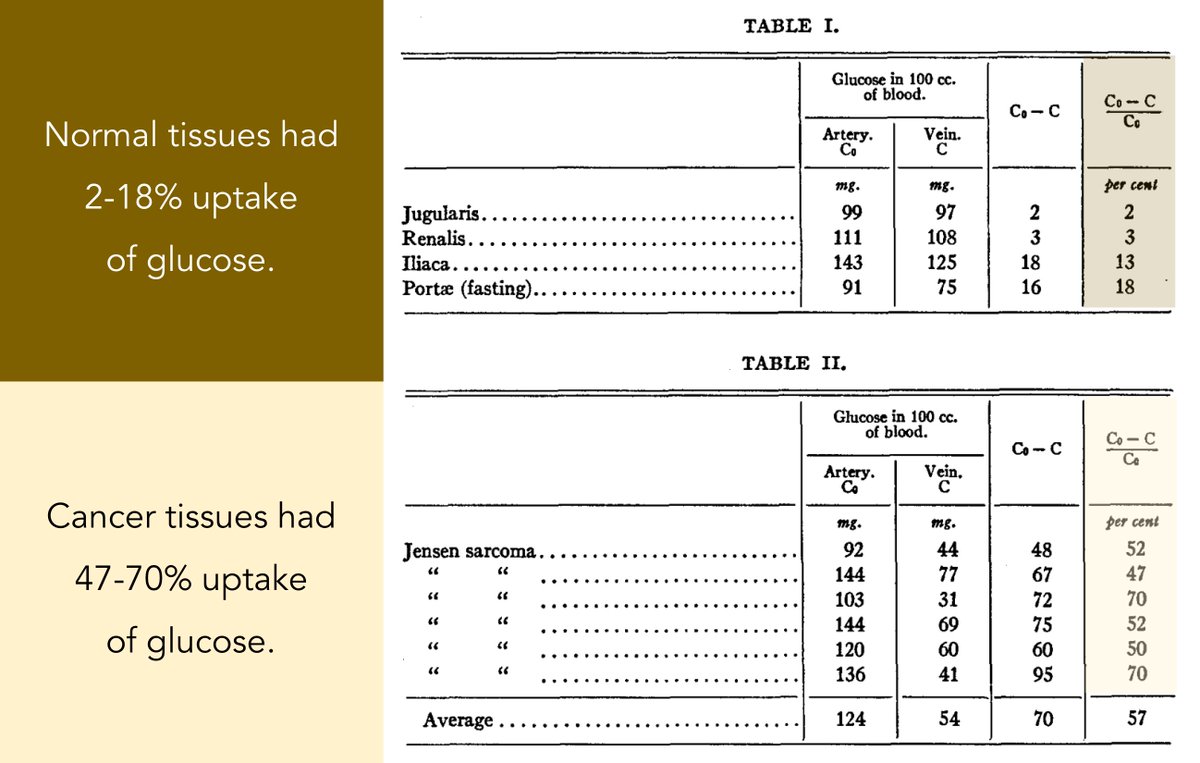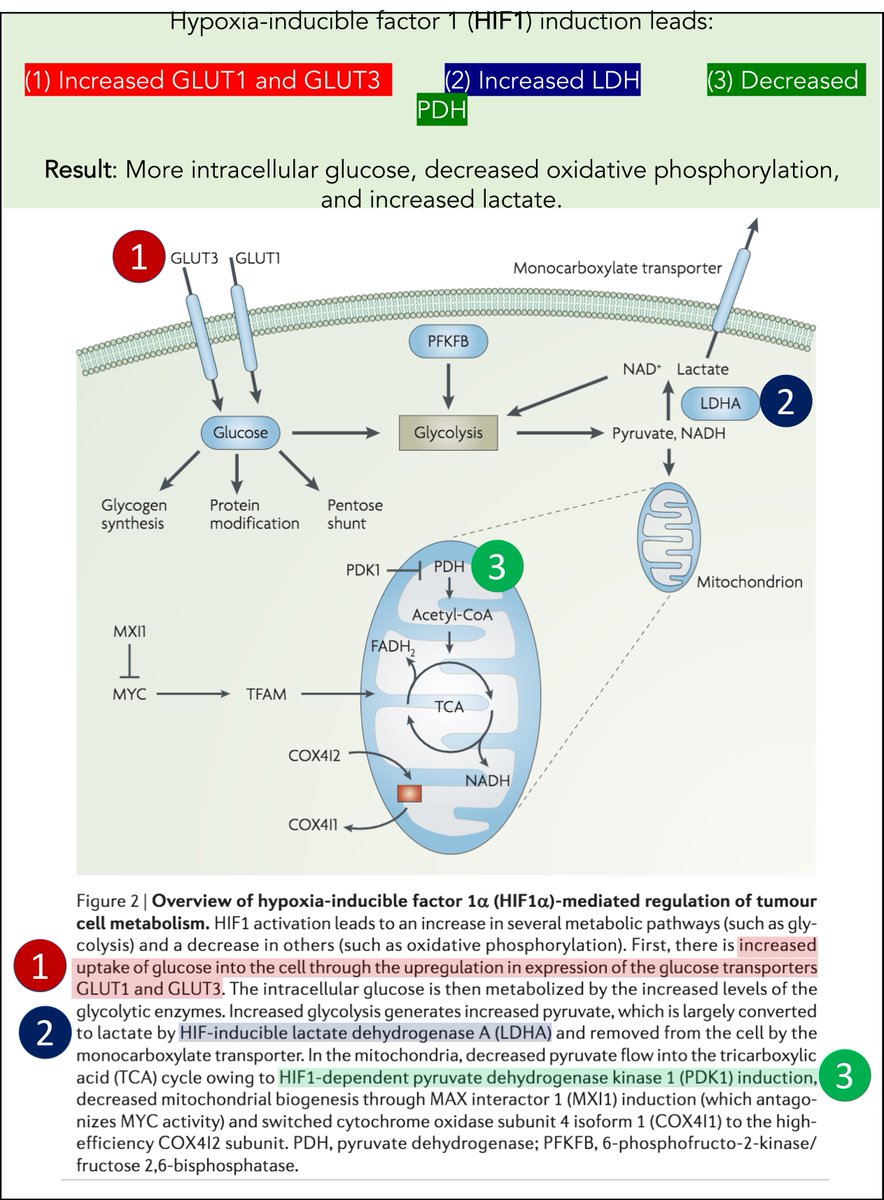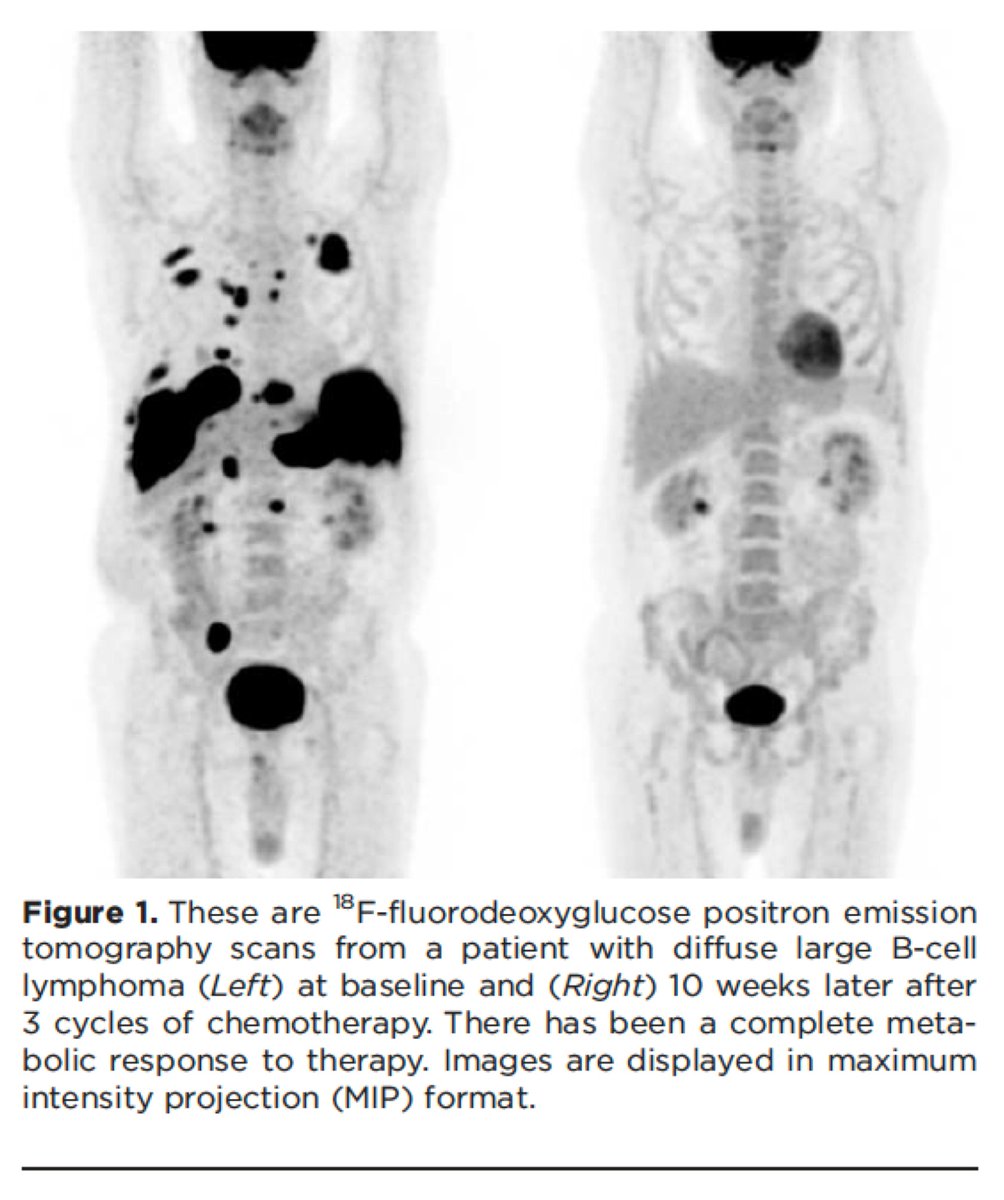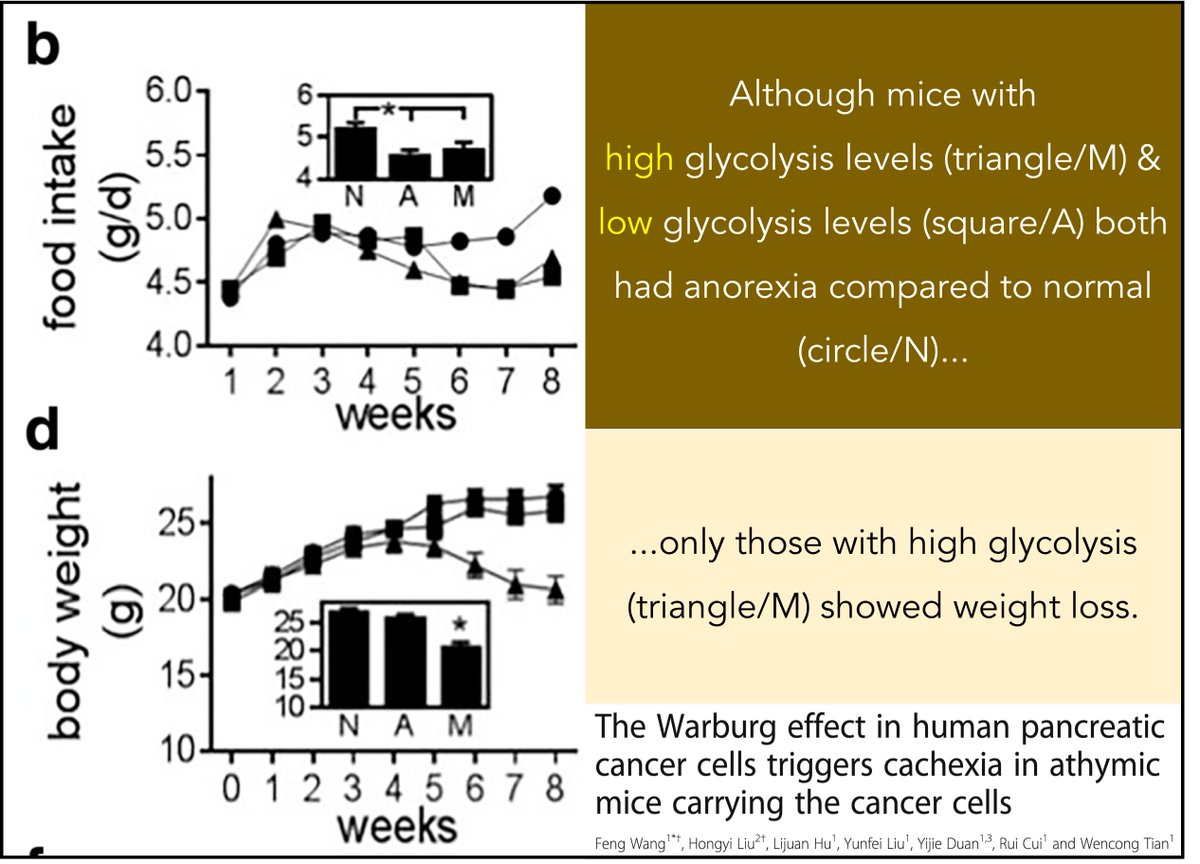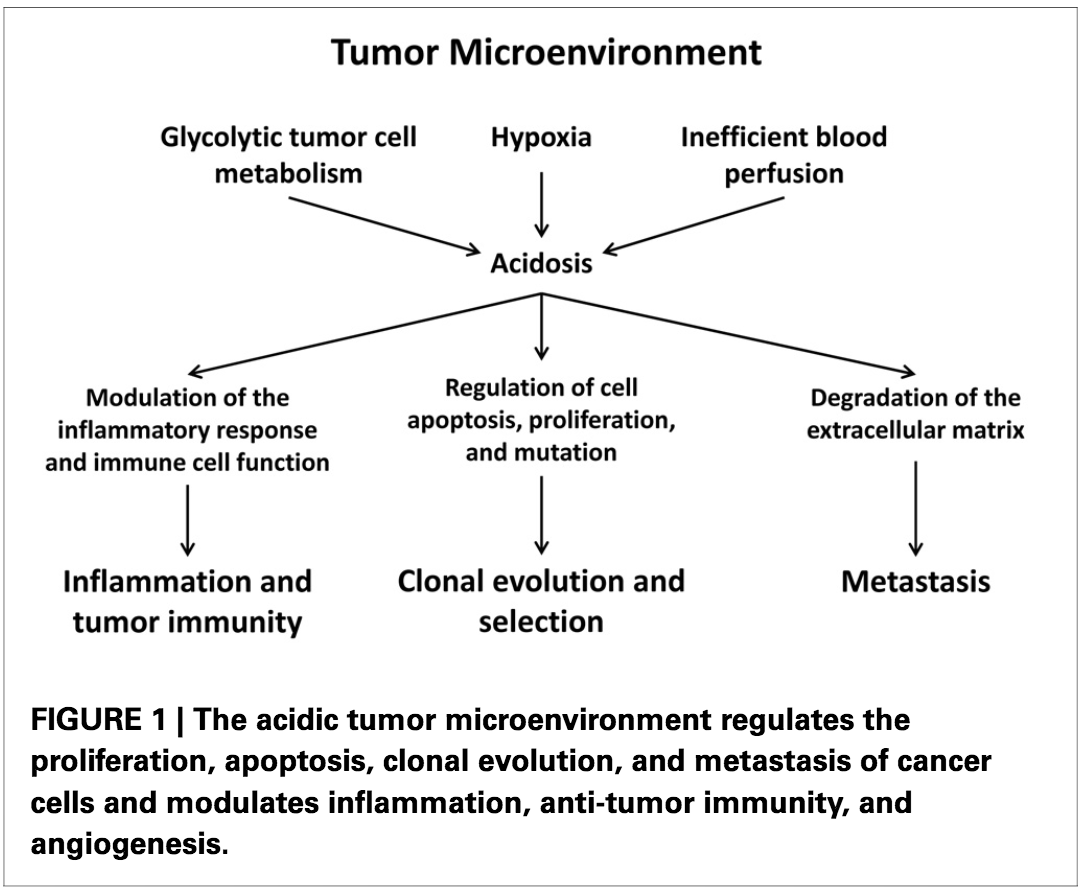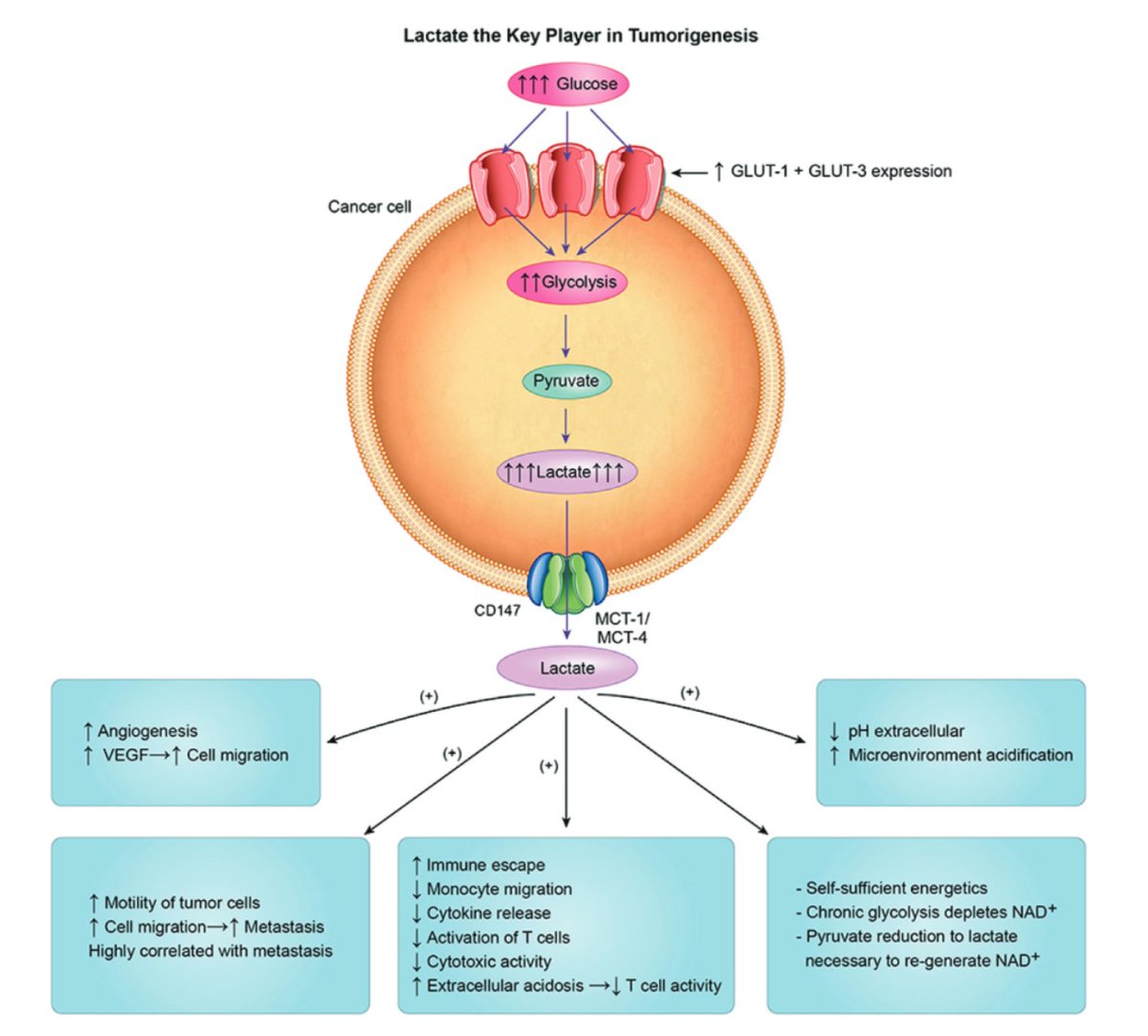1/16
Why is cancer associated with elevated lactate dehydrogenase (LDH)?
The answer is cool and provides insights into cancer that may not be obvious at first. So, what do you think?
What do you think provides the best explanation?
Why is cancer associated with elevated lactate dehydrogenase (LDH)?
The answer is cool and provides insights into cancer that may not be obvious at first. So, what do you think?
What do you think provides the best explanation?
2/
Before getting to the answer, let& #39;s establish that cancer is associated with increased serum LDH levels.
This link has been observed for decades. Here is one of the earlier studies, from 1954.
https://www.ncbi.nlm.nih.gov/pubmed/13190533 ">https://www.ncbi.nlm.nih.gov/pubmed/13...
Before getting to the answer, let& #39;s establish that cancer is associated with increased serum LDH levels.
This link has been observed for decades. Here is one of the earlier studies, from 1954.
https://www.ncbi.nlm.nih.gov/pubmed/13190533 ">https://www.ncbi.nlm.nih.gov/pubmed/13...
3/
There are a number of potential explanations for this observation.
I often hear that LDH is increased in cancer due to "increased turnover". But, cancer is associated with increased proliferation and decreased apoptosis.
Something else is going no.
https://www.ncbi.nlm.nih.gov/pubmed/21943236 ">https://www.ncbi.nlm.nih.gov/pubmed/21...
There are a number of potential explanations for this observation.
I often hear that LDH is increased in cancer due to "increased turnover". But, cancer is associated with increased proliferation and decreased apoptosis.
Something else is going no.
https://www.ncbi.nlm.nih.gov/pubmed/21943236 ">https://www.ncbi.nlm.nih.gov/pubmed/21...
4/
An alternative explanation: cancer overexpresses (i.e., makes more) LDH.
This overexpression has been demonstrated, with control by both c-myc and hypoxia-inducible factor 1 (HIF-1).
https://www.ncbi.nlm.nih.gov/pubmed/9192621 ">https://www.ncbi.nlm.nih.gov/pubmed/91...
An alternative explanation: cancer overexpresses (i.e., makes more) LDH.
This overexpression has been demonstrated, with control by both c-myc and hypoxia-inducible factor 1 (HIF-1).
https://www.ncbi.nlm.nih.gov/pubmed/9192621 ">https://www.ncbi.nlm.nih.gov/pubmed/91...
5/
In order to understand the clinical implications of LDH overexpression, recall it is an enzyme that:
reduces pyruvate to lactate...
...under conditions of high glycolytic flux...
https://www.ncbi.nlm.nih.gov/pubmed/27993896 ">https://www.ncbi.nlm.nih.gov/pubmed/27...
In order to understand the clinical implications of LDH overexpression, recall it is an enzyme that:
reduces pyruvate to lactate...
...under conditions of high glycolytic flux...
https://www.ncbi.nlm.nih.gov/pubmed/27993896 ">https://www.ncbi.nlm.nih.gov/pubmed/27...
6/
...conditions like cancer!
Nearly 100 years ago Warburg and Minami found that cancer cells were characterized by accelerated glycolysis and excessive lactate formation even under fully oxygenated conditions.
This has been called the Warburg Effect.
https://link.springer.com/article/10.1007%2FBF01712130">https://link.springer.com/article/1...
...conditions like cancer!
Nearly 100 years ago Warburg and Minami found that cancer cells were characterized by accelerated glycolysis and excessive lactate formation even under fully oxygenated conditions.
This has been called the Warburg Effect.
https://link.springer.com/article/10.1007%2FBF01712130">https://link.springer.com/article/1...
7/
Warburg also demonstrated that glucose update is 47-70% in tumor cells versus 2-18% in non-tumor cells.
And: tumor cells convert 66% of glucose to lactate.
https://www.ncbi.nlm.nih.gov/pubmed/19872213 ">https://www.ncbi.nlm.nih.gov/pubmed/19...
Warburg also demonstrated that glucose update is 47-70% in tumor cells versus 2-18% in non-tumor cells.
And: tumor cells convert 66% of glucose to lactate.
https://www.ncbi.nlm.nih.gov/pubmed/19872213 ">https://www.ncbi.nlm.nih.gov/pubmed/19...
8/
So, cancer cells overexpress LDH, overproduce lactate, and overconsume glucose.
Three questions follow from these observations:
➢ How do cancer cells do this?
➢ Why do they do this?
➢ What are the clinical implications?
So, cancer cells overexpress LDH, overproduce lactate, and overconsume glucose.
Three questions follow from these observations:
➢ How do cancer cells do this?
➢ Why do they do this?
➢ What are the clinical implications?
9/
First, how.
As noted above, overexpression of c-Myc and HIF-1 is seen in cancer. This leads to a shift to glycolysis.
For example, HIF-1:
↑GLUT-1 (↑intracellular glucose!)
↓pyruvate dehydrogenase (↓oxidative phosphorylation!)
↑LDH (↑lactate)
https://www.ncbi.nlm.nih.gov/pubmed/19143055 ">https://www.ncbi.nlm.nih.gov/pubmed/19...
First, how.
As noted above, overexpression of c-Myc and HIF-1 is seen in cancer. This leads to a shift to glycolysis.
For example, HIF-1:
↑GLUT-1 (↑intracellular glucose!)
↓pyruvate dehydrogenase (↓oxidative phosphorylation!)
↑LDH (↑lactate)
https://www.ncbi.nlm.nih.gov/pubmed/19143055 ">https://www.ncbi.nlm.nih.gov/pubmed/19...
10/
Clinical implication #1:
The reason that cancer lights up on a PET-CT is that cancer cells take up more glucose than the surrounding tissues.
And they take up more glucose for the reasons noted in the preceding tweets.
https://www.ncbi.nlm.nih.gov/pubmed/24947987 ">https://www.ncbi.nlm.nih.gov/pubmed/24...
Clinical implication #1:
The reason that cancer lights up on a PET-CT is that cancer cells take up more glucose than the surrounding tissues.
And they take up more glucose for the reasons noted in the preceding tweets.
https://www.ncbi.nlm.nih.gov/pubmed/24947987 ">https://www.ncbi.nlm.nih.gov/pubmed/24...
11/
Clinical implication #2:
Cancer cells use glucose and produce lactate, which is sent to the liver and recycled back to glucose. This is energy-dependent. To keep up, fat and muscle are catabolized.
Result: one potential cause of cancer cachexia.
https://www.ncbi.nlm.nih.gov/pubmed/29609556 ">https://www.ncbi.nlm.nih.gov/pubmed/29...
Clinical implication #2:
Cancer cells use glucose and produce lactate, which is sent to the liver and recycled back to glucose. This is energy-dependent. To keep up, fat and muscle are catabolized.
Result: one potential cause of cancer cachexia.
https://www.ncbi.nlm.nih.gov/pubmed/29609556 ">https://www.ncbi.nlm.nih.gov/pubmed/29...
12/
But WHY do cancer cells prefer glycolysis to oxidative phosphorylation (given that the latter produces so much more ATP per glucose)?
But WHY do cancer cells prefer glycolysis to oxidative phosphorylation (given that the latter produces so much more ATP per glucose)?
13/
Cancer cells prefer glycolysis for many reasons.
A lot is driven by a desire for lactate.
Remember, ↑LDH leads to ↑lactate. Much of this lactate is shuttled OUT of the cancer cell, leading to an acidic local environment.
This may benefit tumors.
https://www.ncbi.nlm.nih.gov/pubmed/24367336 ">https://www.ncbi.nlm.nih.gov/pubmed/24...
Cancer cells prefer glycolysis for many reasons.
A lot is driven by a desire for lactate.
Remember, ↑LDH leads to ↑lactate. Much of this lactate is shuttled OUT of the cancer cell, leading to an acidic local environment.
This may benefit tumors.
https://www.ncbi.nlm.nih.gov/pubmed/24367336 ">https://www.ncbi.nlm.nih.gov/pubmed/24...
14/
There are other potential benefits of all the extra lactate:
↑angiogenesis
↑tumor migration
↑immune escape
It seems that lactate is not just a byproduct of the Warburg effect, but potentially its intent.
https://www.ncbi.nlm.nih.gov/pubmed/27993896 ">https://www.ncbi.nlm.nih.gov/pubmed/27...
There are other potential benefits of all the extra lactate:
↑angiogenesis
↑tumor migration
↑immune escape
It seems that lactate is not just a byproduct of the Warburg effect, but potentially its intent.
https://www.ncbi.nlm.nih.gov/pubmed/27993896 ">https://www.ncbi.nlm.nih.gov/pubmed/27...
15/
Before closing, let& #39;s ask the original question once more.
 https://abs.twimg.com/emoji/v2/... draggable="false" alt="💥" title="Symbol für eine Kollision" aria-label="Emoji: Symbol für eine Kollision">Why is cancer associated with elevated lactate dehydrogenase (LDH)?
https://abs.twimg.com/emoji/v2/... draggable="false" alt="💥" title="Symbol für eine Kollision" aria-label="Emoji: Symbol für eine Kollision">Why is cancer associated with elevated lactate dehydrogenase (LDH)? https://abs.twimg.com/emoji/v2/... draggable="false" alt="💥" title="Symbol für eine Kollision" aria-label="Emoji: Symbol für eine Kollision">
https://abs.twimg.com/emoji/v2/... draggable="false" alt="💥" title="Symbol für eine Kollision" aria-label="Emoji: Symbol für eine Kollision">
Before closing, let& #39;s ask the original question once more.
16/16 SUMMARY
➢ Cancer cells preferentially use glycolysis
➢ The shift to glycolysis is mediated by c-myc, HIF-1 (and others)
➢ LDH is overexpressed in cancer, leading to more lactate production (and high serum levels)
➢ PET-CT makes use of this
➢ Cancer cells preferentially use glycolysis
➢ The shift to glycolysis is mediated by c-myc, HIF-1 (and others)
➢ LDH is overexpressed in cancer, leading to more lactate production (and high serum levels)
➢ PET-CT makes use of this

 Read on Twitter
Read on Twitter